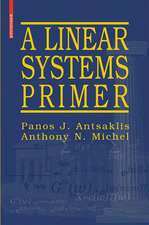Discontinuous Control Systems: Frequency-Domain Analysis and Design
Autor Igor Boikoen Limba Engleză Hardback – 3 dec 2008
Preț: 892.11 lei
Preț vechi: 1087.94 lei
-18% Nou
Puncte Express: 1338
Preț estimativ în valută:
170.71€ • 178.68$ • 142.08£
170.71€ • 178.68$ • 142.08£
Carte tipărită la comandă
Livrare economică 31 martie-14 aprilie
Preluare comenzi: 021 569.72.76
Specificații
ISBN-13: 9780817647520
ISBN-10: 081764752X
Pagini: 212
Ilustrații: XIV, 212 p.
Dimensiuni: 155 x 235 x 15 mm
Greutate: 0.48 kg
Ediția:2009
Editura: Birkhäuser Boston
Colecția Birkhäuser
Locul publicării:Boston, MA, United States
ISBN-10: 081764752X
Pagini: 212
Ilustrații: XIV, 212 p.
Dimensiuni: 155 x 235 x 15 mm
Greutate: 0.48 kg
Ediția:2009
Editura: Birkhäuser Boston
Colecția Birkhäuser
Locul publicării:Boston, MA, United States
Public țintă
ResearchCuprins
The locus of a perturbed relay system theory.- The servo problem in discontinuous control systems.- The locus of a perturbed relay system (LPRS) theory.- Input-output analysis of relay servo systems.- Analysis of sliding modes in the frequency domain.- Performance analysis of second-order SM control algorithms.- Applications of the locus of a perturbed relay system.- Relay pneumatic servomechanism design.- Relay feedback test identification and autotuning.- Performance analysis of the sliding mode—based analog differentiator and dynamical compensator.- Analysis of sliding mode observers.
Recenzii
From the reviews:
“The purpose of this book is to present a new frequency domain theory of discontinuous control systems in which the control systems are viewed and studied as servo systems. … This book is primarily a research monograph, as it is devoted only to frequency domain theory of discontinuous control systems. … it also has many features of textbook, as the theory presented covers a relatively large classic nonlinear control area. The book, therefore, can be used by researcher, practitioners, and undergraduate and graduate students.” (Ion Bogdan, Iasi Polytechnic Magazine, Vol. 21 (1/4), March/December, 2009)
“The purpose of this book is to present a new frequency domain theory of discontinuous control systems in which the control systems are viewed and studied as servo systems. … This book is primarily a research monograph, as it is devoted only to frequency domain theory of discontinuous control systems. … it also has many features of textbook, as the theory presented covers a relatively large classic nonlinear control area. The book, therefore, can be used by researcher, practitioners, and undergraduate and graduate students.” (Ion Bogdan, Iasi Polytechnic Magazine, Vol. 21 (1/4), March/December, 2009)
Textul de pe ultima copertă
Discontinuous control systems are one of the most important and oldest types of nonlinear systems; however, the available methods of analysis of their input-output properties are based on the approximate describing function method, which narrows the application of existing techniques to systems having good low-pass filtering properties. This book provides new insight on the problem of closed-loop performance and oscillations in discontinuous control systems, covering the class of systems that do not necessarily have low-pass filtering properties. The author provides a practical, yet rigorous and exact approach to analysis and design of discontinuous control systems via application of a novel frequency-domain tool: the locus of a perturbed relay system (LPRS).
LPRS theory is presented in detail beginning with basic concepts and progressing to computing formulas, algorithms, and MATLAB® code. As a result of LPRS properties such as exactness, simplicity, and convenience, many problems of analysis and design of discontinuous systems are solved easily by using the theory described. Presented are a number of practical examples applying the theory to analysis and design of discontinuous control systems from various branches of engineering, including electro-mechanical systems, process control, and electronics.
A few chapters of the book are devoted to frequency-domain theory of sliding mode control, which is presented as a special type of discontinuous control. LPRS analysis of the effects of chattering and nonideal closed-loop performance in sliding mode systems having parasitic dynamics, as well as the relationship of those effects with the ideal sliding mode, are given.
Discontinuous Control Systems is intended for readers who have knowledge of linear control theory and will be of interest to graduate students, researchers, and practicing engineers involved in systems analysis and design.
LPRS theory is presented in detail beginning with basic concepts and progressing to computing formulas, algorithms, and MATLAB® code. As a result of LPRS properties such as exactness, simplicity, and convenience, many problems of analysis and design of discontinuous systems are solved easily by using the theory described. Presented are a number of practical examples applying the theory to analysis and design of discontinuous control systems from various branches of engineering, including electro-mechanical systems, process control, and electronics.
A few chapters of the book are devoted to frequency-domain theory of sliding mode control, which is presented as a special type of discontinuous control. LPRS analysis of the effects of chattering and nonideal closed-loop performance in sliding mode systems having parasitic dynamics, as well as the relationship of those effects with the ideal sliding mode, are given.
Discontinuous Control Systems is intended for readers who have knowledge of linear control theory and will be of interest to graduate students, researchers, and practicing engineers involved in systems analysis and design.
Caracteristici
A novel frequency-domain tool is presented in detail Only book on discontinuous systems that covers the frequency-domain approach Provides an alternative treatment of sliding mode control in discontinuous control systems Practical examples are presented, with applications to electro-mechanical systems, process control, and electronics LPRS theory is presented in detail beginning with basic concepts and progressing to computing formulas, algorithms, and MATLAB® code Includes supplementary material: sn.pub/extras















